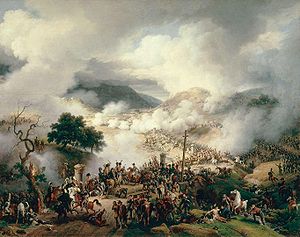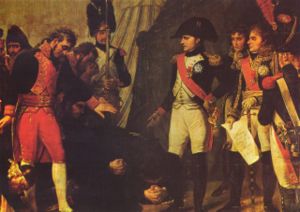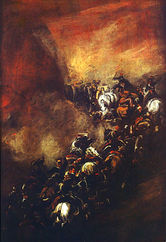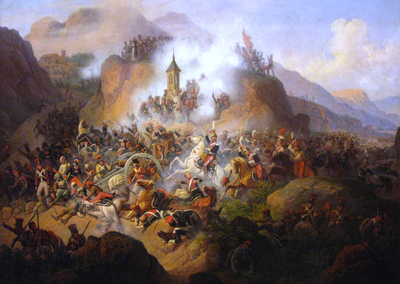- Battle of Somosierra
-
Battle of Somosierra Part of the Peninsular War 
La bataille de Somo-Sierra, by Baron Lejeune, 1810, oil on canvas.Date November 30, 1808 Location Somosierra Pass, north of Madrid, Spain Result French victory Belligerents  French Empire
French Empire
Duchy of Warsaw
 Spain
SpainCommanders and leaders Napoleon I
Jan Leon KozietulskiBenito de San Juan Strength 45,000 8,000 infantry,
16 gunsCasualties and losses Unknown[1] 250 dead or wounded,
3,000 capturedPeninsular WarNapoleon's campaign, 1808–1809
The Battle of Somosierra occurred November 30, 1808 in the Peninsular War, when a French army under Napoleon I forced a passage through the Sierra de Guadarrama shielding Madrid.
At the Somosierra mountain pass, 60 miles north of Madrid, a heavily outnumbered Spanish detachment of conscripts and artillery under Benito de San Juan aimed to block Napoleon's advance on the Spanish capital. Napoleon overwhelmed the Spanish positions in a combined arms attack, charging the Polish Chevau-légers of the Imperial Guard at the Spanish guns while French infantry advanced up the slopes. The victory removed the last obstacle barring the road to Madrid, which fell several days later.
Contents
Background
By late November 1808, the French Grande Armée had overwhelmed and destroyed both wings of the Spanish popular army. To complete his reconquest of Spain, Napoleon advanced on Madrid with 40,000 men.
General San Juan mustered an ad hoc army of militia, reservists, and various regular regiments still reeling from earlier defeats; in all about 12,000 men, to defend Madrid. In order to screen the many approaches to the city, San Juan dispersed his already greatly outnumbered forces. Under his orders, 9,000 men were dispatched west to guard the Guadarrama pass while 3,000 occupied an advanced post at Sepulveda, leaving only 9,000 men and 16 guns on the heights of Somosierra.
Somosierra pass
The nature of the terrain and the tenacity of the Spaniards initially worked in their favour. On the evening of November 29 the brigade at Sepulveda repulsed a French attack, inflicted heavy casualties, and escaped from overwhelming French numbers in the gathering darkness to the west. The following morning, Napoleon advanced his infantry directly toward the pass while small detachments crept up the flanks. Exchanging musket volleys with the defenders, the French made slow but measurable progress toward the enemy guns.
The Polish charge
Because the Spanish forces could not easily be outflanked by infantry movement, and Napoleon was impatient to proceed, he ordered his Polish Chevaux-Légers escort squadron of 125 men[2] to charge the Spaniards and their fortified artillery batteries. To that number must be added members of other squadrons, totalling some 450 men, but who entered the battle later. The charge of 125 against batteries was joined by Niegolewski's platoon returning from reconnaissance. It is not clear, however, whether the number included only front-line troops (sabres) or all the soldiers in the units. The decision, arguably callous and imprudent, has been the subject of much historical controversy.[who?] Napoleon issued no written orders. Jan Kozietulski, who commanded the 3rd squadron that day, mentioned that he called, "Lekka jazda kłusem!" ("Light cavalry at the trot!") and, passing the little bridge, added, "En avant, Vive l'Empereur!".
Some western authors [3] have assumed that Napoleon had gone out of his mind in ordering the Poles to charge batteries of 16 cannon over several kilometers of extremely difficult terrain. Others,[who?] however, think Napoleon ordered only the closest battery to be taken, in order to open the way for his infantry, and that Kozietulski had misunderstood the order. No matter, once the charge had begun, and the chevaux-légers found themselves under fire from the second battery, they had no choice but to press the attack as the horses went to the highest speed and were unable to stop. They took the second and third batteries, but only a few chevaux-légers reached the last battery, and the Spanish attempted to recapture it. It was then that Napoleon saw his chance and immediately committed the other squadrons.
Benito de San Juan had 16 cannon at his disposal, arranged in four batteries. Some accounts, based mostly on relations of French officers, assume that the Spaniards placed all their guns at the peak of Somosierra pass. However, with a range of 600–800 metres, the cannons, deployed in this fashion, could not have struck much of the French army—and relations report that Napoleon himself was at times put under artillery fire. Also, the chevaux-légers that took part in the charge, as well as the Spanish prisoners captured before the battle, mentioned that Benito de San Juan had cannons in four batteries, not one. The first battery defended the entrance to the Somosierra pass, the next two covered the pass at its angles, and the fourth, only, stood by the heights. It was assumed that all batteries had four cannons, and latter theories that the pass was too narrow for that to be possible should be treated as legends.
13th Bulletin of the Army of Spain mentioned that chevau-légers were commanded by Gen. Louis Pierre, Count Montbrun. However, both Polish charge participants mentioned above and Lt. Col. Pierre Dautancourt, one of the French tutors of the unit, stressed in their relations that such was not the case. Datancourt mentioned in his relation that Montbrun in conversations with him himself was laughing from that idea. Yet French historian Adolphe Thiers gave him the honour of leading the charge, which caused the protest by Polish living participants of the battle. Maj. Philippe de Ségur in his memoirs wrote that he had commanded the charge, but his relations were often described as unreliable and again both Dautancourt and the Poles denied his role.
The charge was led by Kozietulski, but he lost his horse after taking the first battery. The squadron was then joined by Lt. Andrzej Niegolewski, who had previously been on reconnaissance with his soldiers. The charge was continued under Dziewanowski, and when he fell from the horse after taking the third battery, by Piotr Krasiński. The charge which continued to the last battery was led by Niegolewski, who survived almost by miracle when Spanish attacked him (he received nine wounds from bayonets and two carbine shots to the head).
According to many memoirs of the veterans of the battle, Kozietulski led his men for a charge with the official cry Vive l'Empereur. However, a popular legend has it that the true battle cry was in Polish Naprzód psiekrwie, Cesarz patrzy - Forward, you sons of dogs, the Emperor is watching.[4]
When the fourth battery was taken Napoleon ordered his Chasseurs of the Guard, and 1st squadron of Poles led by Tomasz Łubieński to resume the attack and repulse Spaniards from the Pass. Łubieński tried to give himself the whole glory, trying to minimise the role of the third squadron (while Niegolewski tried to show that he had taken the cannons and Łubieński had therefore had it so easy as Spanish were shooting at him "with candies").
Charge effects
French officers tried to minimise the effect of the Polish charge, saying that all the success should be given to French infantry of Gen. François Ruffin[citation needed]. Yet still 13th bulletin of the Army of Spain mentioned lead role of Polish chevaux-légers. However, only cavalry charge was able to take all four batteries, even if French infantry was close enough to press their attack, and caused en-masse retreat of Spanish Andalusian irregular militia and in the effect retreat of the whole army. It must be noted that Spanish artillery men preferred to die than abandon their position - but no Polish relation mentioned any fight with Spanish militia. Militiamen just left their position seeing how seemingly easily Poles took the artillery positions. In the smoke they could not see how few Poles were on the top.
Aftermath
 Surrender of Madrid, by Antoine-Jean Gros, 1810, oil on canvas. Madrid fell in the aftermath of Somosierra.
Surrender of Madrid, by Antoine-Jean Gros, 1810, oil on canvas. Madrid fell in the aftermath of Somosierra.
San Juan raced his army back to Madrid. Although the victory at Somosierra was more accurately the result of a combined infantry and cavalry attack, with the infantry bearing the heavier fighting, later accounts, Napoleon's included, placed all the emphasis on the Polish charge. San Juan was later killed by his own men.[citation needed]
French patrols reached the outskirts of Madrid on December 1. The Junta made a half-hearted and futile attempt to defend the capital, and on December 4, a devastating French artillery barrage brought the Spanish defence to grief. Spaniards surrendered their remaining 2,500 regulars; the 20,000 civilians under their banner dispersed; and the French entered Madrid for the second time that year.
External links
Notes and references
- ^ Unit registers showed the deaths (not counting the officers) as 12 Poles from 3rd squadron (plus 2 others who died from wounds), and 2 from 1st squadron and 4 from 2nd squadron (plus one who died later from wounds). With officers, total losses were 18 dead and 11 wounded, from which 5 later died from wounds. Those were large losses, but all Polish squadrons were operational within few days after the battle. Datancourt mentioned in his relation 57 dead and wounded.
- ^ Unit registers showed that the squadron numbered 125.
- ^ Geoffrey Regan, Great military blunders ISBN 978-0752218441
- ^ (Polish) Andrzej Nieuważny (May 2006). "Najpiękniejsza z szarż (The Most Beautiful of Cavalry charges)". Rzeczpospolita 123 (2006-05-27). Cf. word of Cambronne
Categories:- Conflicts in 1808
- Battles of the Peninsular War
- Battles involving Spain
- Battles involving Poland
- 1808 in Spain
Wikimedia Foundation. 2010.



